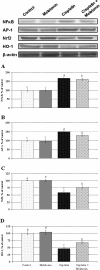Melatonin suppresses cisplatin-induced nephrotoxicity via activation of Nrf-2/HO-1 pathway
- PMID: 23311701
- PMCID: PMC3561216
- DOI: 10.1186/1743-7075-10-7
Melatonin suppresses cisplatin-induced nephrotoxicity via activation of Nrf-2/HO-1 pathway
Abstract
Background: Cisplatin, one of the most effective and potent anticancer drugs, is used in the treatment of a wide variety of both pediatric and adult malignancies. However, the chemotherapeutic use of cisplatin is limited by its serious side-effects such as nephrotoxicity and ototoxicity. Cisplatin chemotherapy induces a reduction in the antioxidant status, leading to a failure of the antioxidant defense against free-radical damage generated by antitumor drugs. Cisplatin-induced oxidative stress in the kidney was partially prevented by antioxidant treatments using superoxide dismutase, glutathione, selenium and flavonoids. Melatonin and its metabolites possess free-radical scavenging activity and it has been shown that they protect against cisplatin toxicity. However, the mechanism of the protective effects of melatonin against cisplatin-induced nephrotoxicity is still essentially unknown. We therefore designed this study to investigate the underlying mechanism of the protective effect of melatonin against cisplatin-induced renal damage in a rat nephrotoxicity model in vivo.
Methods: Twenty eight 8-week-old male Wistar rats were divided into four groups of control, melatonin treatment (4 mg/kg b.w i.p. for 10 days), cisplatin treatment (7 mg/kg b.w., i.p.) and melatonin and cisplatin combination treatment. Serum urea nitrogen (urea-N) and creatinine levels were measured. Histopathological changes were evaluated. In addition, we analyzed the expression levels of HO-1, Nrf2, NF-κB and AP-1 in Western blot analysis.
Results: Both serum creatinine and urea nitrogen increased significantly following cisplatin administration alone; these values decreased significantly with melatonin co-treatment of cisplatin-treated rats. Histological analysis showed that cisplatin caused damage in the proximal tubular cells in the kidneys of cisplatin-treated rats; these changes were reversed by melatonin co-treatment. Upon Western blot analysis, melatonin treatment increased Nrf2 accumulation in the nuclear fraction, and increased the expression of HO-1 in the cytosolic fraction as compared to the cisplatin-treated rats. Expressions of NF-κB p65 and AP-1 were increased significantly in the kidneys of rats treated with cisplatin compared with the expression in the kidneys from the control, melatonin-only-treated and melatonin co-treated rats.
Conclusion: Our present data suggest that melatonin attenuates cisplatin-induced nephrotoxicity possibly by modulating Nrf2/HO-1 signaling.
Figures


Similar articles
-
Melatonin, a pineal secretory product with antioxidant properties, protects against cisplatin-induced nephrotoxicity in rats.J Pineal Res. 2001 Apr;30(3):129-38. doi: 10.1034/j.1600-079x.2001.300301.x. J Pineal Res. 2001. PMID: 11316323
-
Embelin attenuates cisplatin-induced nephrotoxicity: Involving inhibition of oxidative stress and inflammation in addition with activation of Nrf-2/Ho-1 pathway.Biofactors. 2019 May;45(3):471-478. doi: 10.1002/biof.1502. Epub 2019 Mar 20. Biofactors. 2019. PMID: 30893507
-
Epigallocatechin-3-gallate activates Nrf2/HO-1 signaling pathway in cisplatin-induced nephrotoxicity in rats.Life Sci. 2010 Aug 14;87(7-8):240-5. doi: 10.1016/j.lfs.2010.06.014. Epub 2010 Jul 6. Life Sci. 2010. PMID: 20619277
-
Melatonin and cisplatin co-treatment against cancer: A mechanistic review of their synergistic effects and melatonin's protective actions.Pathol Res Pract. 2024 Jan;253:155031. doi: 10.1016/j.prp.2023.155031. Epub 2023 Dec 12. Pathol Res Pract. 2024. PMID: 38103362 Review.
-
Prevention of cisplatin nephrotoxicity.J Nephropharmacol. 2015 Aug 22;5(1):57-60. eCollection 2016. J Nephropharmacol. 2015. PMID: 28197500 Free PMC article. Review.
Cited by
-
Procyanidin A1 Alleviates Inflammatory Response induced by LPS through NF-κB, MAPK, and Nrf2/HO-1 Pathways in RAW264.7 cells.Sci Rep. 2019 Oct 21;9(1):15087. doi: 10.1038/s41598-019-51614-x. Sci Rep. 2019. PMID: 31636354 Free PMC article.
-
Protective effects of zingerone on cisplatin-induced nephrotoxicity in female rats.Environ Sci Pollut Res Int. 2019 Aug;26(22):22562-22574. doi: 10.1007/s11356-019-05505-3. Epub 2019 Jun 4. Environ Sci Pollut Res Int. 2019. PMID: 31165450
-
Tangeretin protects renal tubular epithelial cells against experimental cisplatin toxicity.Iran J Basic Med Sci. 2019 Feb;22(2):179-186. doi: 10.22038/ijbms.2018.32010.7691. Iran J Basic Med Sci. 2019. PMID: 30834084 Free PMC article.
-
DNA Methylation of miR-7 is a Mechanism Involved in Platinum Response through MAFG Overexpression in Cancer Cells.Theranostics. 2017 Sep 22;7(17):4118-4134. doi: 10.7150/thno.20112. eCollection 2017. Theranostics. 2017. PMID: 29158814 Free PMC article.
-
Melatonin modulates microsomal PGE synthase 1 and NF-E2-related factor-2-regulated antioxidant enzyme expression in LPS-induced murine peritoneal macrophages.Br J Pharmacol. 2014 Jan;171(1):134-44. doi: 10.1111/bph.12428. Br J Pharmacol. 2014. PMID: 24116971 Free PMC article.
References
-
- Safirstein R, Winston J, Goldstein M, Moel D, Dikman S, Guttenplan J. Cisplatin nephrotoxicity. Am J Kidney Dis. 1986;8:356–367. - PubMed
-
- Osanto S, Bukman A, Van Hoek F, Sterk PJ, De Laat JA, Hermans J. Long-term effects of chemotherapy in patients with testicular cancer. J Clin Oncol. 1992;10:574–579. - PubMed
-
- Luke DR, Vadiei K, Lopez-Berestein G. Role of vascular congestion in cisplatin-induced acute renal failure in the rat. Nephrol Dial Transplant. 1992;37(1):1–7. - PubMed
-
- Davis CA, Nick HS, Agarwal A. Manganese superoxide dismutase attenuates cisplatin-induced renal injury: importance of superoxide. J Am Soc Nephrol. 2001;12:2683–2690. - PubMed
LinkOut - more resources
Full Text Sources
Other Literature Sources

